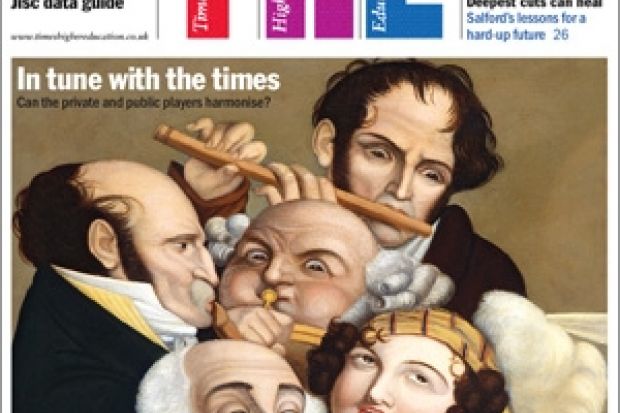A radical change is taking place in universities around the world as fast-expanding private provision offers access to millions of new students. Is this a threat to the traditional sector and to standards of education or is it a challenge that will force the academy to raise its game? Philip G. Altbach outlines the global trends, while overleaf, others consider what the future holds in the UK and the US
Across the world, private higher education has grown remarkably in the past several decades. Today, 30 per cent of global higher education enrolment is private, according to Trends in Global Higher Education, a report for the United Nations Educational, Scientific and Cultural Organisation.
Private higher education has existed in many countries for centuries. It has traditionally been the dominant force in a number of South-East Asian countries, and it constituted a key part of the American higher education landscape. Globally, however, it was a minor element. But now private higher education institutions, many of them for-profit or quasi for-profit, represent the fastest-growing sector worldwide. In Indonesia, Japan, the Philippines, South Korea and Taiwan, more than 70 per cent of students are educated privately; and in countries such as Mexico, Brazil and Chile more than half of students use the private option. Private universities are expanding rapidly in Central and Eastern Europe and in the countries of the former Soviet Union, as well as in Africa. China and India also have significant private sectors.
In general, the private sector is "demand absorbing" - offering access to students who may not be qualified for public institutions or cannot be accommodated because of overcrowding. Some private universities are selective, but most serve a mass clientele and are not seen as prestigious. For-profit institutions constitute a growing higher education subsector, and there is notable growth in developing regions. Other private institutions claim not-for-profit status, but provide income for their owners. The sector is run mostly on a business model, with power concentrated in boards and chief executives and with faculty holding little authority or influence. Most teachers in these new private institutions are professors from the public universities who moonlight to earn extra income - private schools generally have few full-time staff. Students are seen as consumers.
The reasons for the rise of the private sector are not hard to discern. The key factor is governments' inability to accommodate rapidly expanding numbers of would-be students. Private schools have entered the market to provide access and to offer programmes that are, in large part, vocationally oriented. In some parts of the world, public universities have become somewhat dysfunctional. Some have grown too large to provide high-quality instruction or have suffered from budget cuts, while others are rife with political disruption and frequently closed by strikes or demonstrations. Such problems lead students to seek private alternatives.
There is considerable variety within the private sector. Although low-prestige demand-absorbing institutions dominate, in many countries a handful of highly regarded older private universities can be found - often, as in Latin America, sponsored by the Roman Catholic Church. There is also a new band of "semi-prestigious" universities seeking to offer a high-quality education and to compete with established public institutions. In specialised fields such as business administration, private schools have in some countries become leading institutions, attracting the best students.
While a few countries - among them South Korea, Japan and Chile - provide limited public funds to private universities, the private higher education sector is traditionally funded by tuition payments from students. Private institutions always charge more than public universities. This often results in a skewed situation in which the more prestigious public universities provide a less expensive education to students from higher socio-economic groups who can gain entry while the poorer students end up paying top dollar to attend less highly regarded private institutions.
Quality assurance has become a dilemma as governments seek to regulate the burgeoning private sector. Because many countries placed few regulations on the establishment of private institutions, the market attracted operators who were more interested in quick profit than in quality. When evaluation mechanisms were put into place in some Latin American countries, up to half of the private post-secondary institutions were shut down. Now, most countries have quality assurance agencies to ensure at least a minimal standard.
The market is also creeping into areas hitherto out of bounds. In the US, most of the leading public research universities now receive less than a quarter of their operating budgets from the state. Having had to generate the rest from student tuition fees, research, university-industry linkages, the sale of university-related products and other entrepreneurial activities, they are in many ways privatised. The current economic crisis has exacerbated this trend as state allocations have been cut even further. In the rest of the world, however, privatisation of state universities is a new development. Australia and China have been explicit in asking universities to earn more of their operating expenses by generating revenues. In some cases, such financial sources contribute to the commercialisation of the institution and conflict with its traditional roles.
The private higher education sector has become complex and differentiated. There are a small but growing number of relatively high-quality private universities in most countries, while most of the expansion has been at the bottom of the hierarchy. The private sector, dependent almost exclusively on student fees, often serves those students who can least afford high fees - lower-income students who are unable to qualify for subsidised public universities. As the private sector grows, the traditional "public good" values of higher education get sidelined because the private sector typically does not engage in research, does not offer scholarships or other financial aid, and often does not receive government support. In much of the world, the private revolution is reshaping the higher education landscape in ways that are problematic for the traditional values of the academy.
